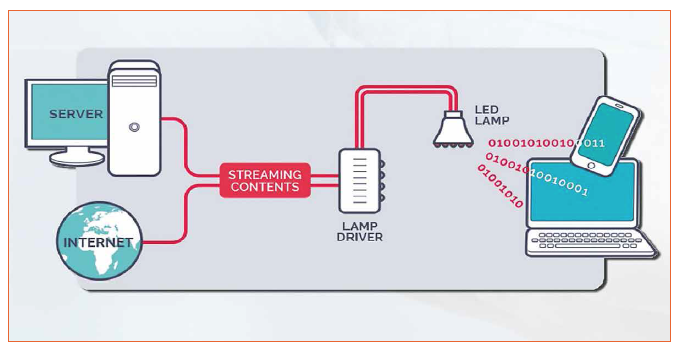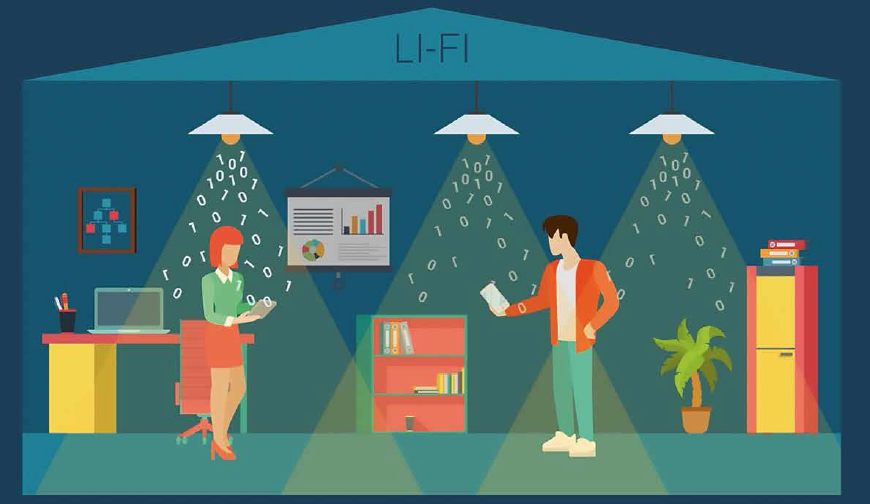LiFi - What It Is, How It Works, What It Provides, How to Apply, and Its Future Prospects
The acronym LiFi (Light Fidelity) was born at the beginning of the 2010s. Its name derives from the very well-known WiFi (Wireless Fidelity). The term VLC (Visible Light Communication) is used in the restricted instances of visible light. Mr. Luc Chassage who works for Oledcomm and the Versailles University is also Scientific Committee President of the Global LiFi Congress that offers 20 lectures dealing with all aspects of LiFi. He is a profound expert in this technology field. Mr. Chassage explains the functionality, pitfalls and hurdles to overcome, the disadvantages and advantages, and best practice to apply LiFi.
LiFi relates to wireless communication technologies which rely on light as a power source. Owing to the incredible increase of LEDs (Light Emitting Diodes) over the last few years, which have become reliable and more affordable, LiFi technology can be integrated on a daily basis. The LEDs can be used like lasers in optical telecommunication in order to transfer data. LED light sources present in our surroundings can therefore be used for lighting but also used to transfer digital data.
Operating Principle
LiFi technology is very simple from a functional point of view. The majority of applications exchange data in digital form. A transmitter, essentially an LED, sometimes a laser, emits light and information simultaneously. We then find the standard elements of a data chain transmission: data, coding and a network. These digital networks modulate the LED transmitter which then allows the transposition of the electrical signal into a light signal.
Then the light signal is freely diffused into a room or outside. Depending on the distance, there is a greater or lesser reduction and according to the various environmental disturbances (rain, sun, other lighting, etc.).
A receiver, made up of a photodetector or a camera upon arrival is responsible for re-transcribing the luminous signal into an operational electrical signal. Coupled with this conversion it is quite frequent especially for high speed links to find the pre-amplification level adapted to the specificities of the chain.
The modulations used are essentially power modulations; the LED is therefore piloted by a switch circuit based on simple electronics. The selected rates of modulation are sufficiently high so as to ensure that the flickering is not visible to the human eye (> 200 Hz).
 Figure 1: Implementation of LiFi in the current infrastructure showing the path data takes from a server to the end user devices
Figure 1: Implementation of LiFi in the current infrastructure showing the path data takes from a server to the end user devices
The receiver at the end of the chain is the most important element in order to ensure a good signal. As well as a photodetector, it can be made up of an optical group more or less sophisticated consisting of lenses of ambient light caches and eventually chromatic filters which accentuate colors. The whole system is responsible for gathering the maximum amount of useful optical power.
Once the signal has been converted into an electrical signal and is sufficiently pre-amplified, various stages of amplification and filtering allow the reconstruction of digital signal and then it can be decoded in order to obtain the initial data. The reconstruction of digital data can be done according to the methods used in the optic fiber transmission chains or radio frequency transmission chains because we are faced with the same problems. Thus we find amplifiers, analogue filters at the beginning of the chain and digital ones at the end of the chain. An equalizer is responsible for adapting the filtering of the channel in real time. Synchronization at the beginning of the network, a reconstruction of timing and finally a decision making level.
The chain described here is unidirectional, which corresponds to the downward track of the emitter towards the user. This one way is sufficient in order to carry out the data transmission, but encounters limits in the case of data to be exchanged. In this case, it is necessary to reproduce the system for the ascending track and to be bidirectional. Current LiFi systems use infrared and non-visible ascending tracks, so as to not disturb the downlink and not to impose on each user a visible transmitter element, which apart from anything else would be extremely problematic. Figure 2: Exemplary data transmission in an open office space via LED light bulbs
Figure 2: Exemplary data transmission in an open office space via LED light bulbs
About the Parallels Between LiFi and WiFi
If the term LiFi comes from the term WiFi, it is because there are number of similarities. These two technologies are competing with one another, but above all are complimentary. WiFi is based on radiofrequency waves and not on light.
WiFi spreads in all directions with spans of more than tens of meters. It can also go through obstacles such as walls. In contrast, LiFi must have line of sight and is guided, with a span of a number of meters.
The available frequencies to emit WiFi are limited; the band which carries the signal cannot be extended. The number of channels simultaneously available is restricted. This is not the case for optical waves which have an almost infinite band in comparison with radio waves. You can therefore theoretically multiply the number of channels and increase the flow of data exchanged.
The two waves, radiofrequency or light, move at the same speed, the speed of light (roughly 300,000 km/s). But the frequency of light waves is far higher than that of radio waves, roughly 200,000 times faster. The theory of transmission of information shows that the higher the frequency of the wave, the more you will be able to carry out this famous and fast amplitude modulation, and have high upload/download speeds.
 Figure 3 & Table: Brief technical comparison between LiFi and WiFi parameters and data transmission capabilities
Figure 3 & Table: Brief technical comparison between LiFi and WiFi parameters and data transmission capabilities
In good conditions current WiFi can achieve download speeds of around 50MB/s. Current records show that LiFi in the laboratory attains 8GB/s, in other words 160 times faster (8GB/s = a few seconds transfer for 1 DVD). These figures are constantly updated!
LiFi in Applications
The presence of LEDs everywhere in our environment is a strong asset for the deployment of LiFi. In all new applications, one can differentiate between two major groups: interior applications and exterior applications.
Interior applications benefit from the buildings' lighting system. One can differentiate applications needing very weak output and applications needing a strong output.
For weak output, LiFi is already used a great deal to locate people or connected objects. In effect it is very simply that each lamp emits through LiFi a unique identifying signal. By linking this signal to a pre-existing mapped out network, one can find one's way in a complicated building, a station, a museum, a factory, a technical center. Localization can be extremely precise, between 10 and 20 cm, and clear. The increase of IoT nodes requires relatively weak connections and can also be a colossal opportunity for LiFi in the years to come.
In parallel, the LiFi industry is making an effort to ensure faster transfers in order to be complimentary to WiFi. Current speeds on industrial prototypes are around a few dozen MBs/s but the potential is far greater.
External applications are also numerous: transmitting between buildings in order to avoid having hard radiofrequency caps, by using the existing infrastructure of towns. The infrastructure, for example, can be the lighting network of towns but equally the road network. One can therefore envisage transmitting information in a targeted and localized fashion. In the very near future, the whole car industry, including vehicles and road infrastructure will use LEDs in their headlights, lampposts, signposts which will be able to relay information between vehicles, pedestrians, infrastructure, public transport, and the millions of connected objects.
Of course this type of data can be exchanged by a radiofrequency link. However, at high speed or in congested environments it is less practical. Moreover, one of the keys to the future of the autonomous vehicle is the duplication of information. Just as on airplanes there are a number of sensors in order to be able to overcome breakdowns and to be robust in all situations, it is also indispensable for the car to have various means of communication.
Conclusions
While there are, in practice, still some hurdles to overcome, the lab results are very promising and in some applications the technology has already proven the capabilities. Transmission speed and data reliability are already on a high level. But as for any technology, there are applications where it performs better or poorer. Therefore, it is important to understand: Radiofrequencies and light are not enemies but allies!
Acknowledgements:
This work was made possible by the Global LiFi Congress which will be held February 8th & 9th, 2018 at the Palais Brongniart, Paris. The congress is supported by the IEEE association and dedicated to LiFi/Visible Light Communication (VLC).
(c) Luger Research e.U. - 2017

